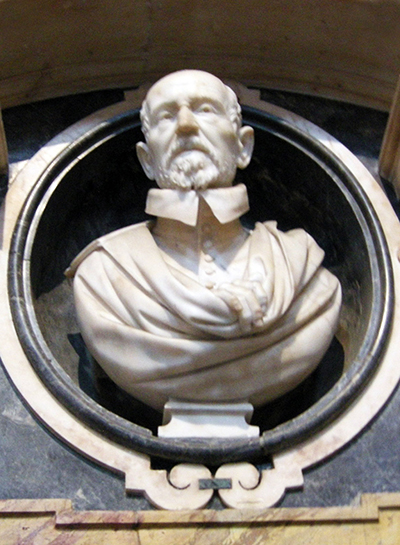The Bust of Giovanni Vigevano is a sculptural portrait, crafted from marble by the Italian artist Gian Lorenzo Bernini.
It is often cited as an example of the Baroque portrait sculpture style that Bernini became synonymous with, and is one of many busts produced by the artist in the early portion of his career. It is generally agreed that the Bust of Giovanni Vigevano was created between 1617 and 1618. After Giovanni Vigevano's death in 1930, the sculpture was inserted into his tomb, which can be found in Rome, within the church of Santa Maria sopra Minerva - one of the major churches of the Roman Catholic Dominican Order.
The sculpture itself is a life-sized portrait, consisting of Giovanni Vigevano's head and upper body. Stylistically, it features several trademark Gian Lorenzo Bernini elements, with the artist being renowned globally for his ability to create realistic portraits from marble, with a life-like quality difficult to create out of single-coloured stone. One of the ways Bernini achieved this feat was to add an element of asymmetry or movement to static compositions. In the case of the Bust of Giovanni Vigevano, this is largely achieved by the position of the subject.
In the bust, Vigevano's head is turned slightly to the left; a feature also seen in several other Bernini works from the period, including the Bust of Pope Paul, which was produced in 1621. This helps to add a sense of movement to the bust, making the collar appear slightly off-centre and avoiding the conventions of a static composition. Another feature of the bust that is in-keeping with Gian Lorenzo Bernini's trademark techniques is the positioning of the eyes. Bernini's portrait sculptures are often identifiable by the presence of eyes with an almost introspective quality, and in this case it is achieved by having the eyes glancing down and to the left.
However, one of the most immediately intriguing aspects of the composition itself is found away from the bust's head. While many of Bernini's busts were more traditional and consisted purely of the head, shoulders and upper torso, this particular bust also features the presence of a hand, adding to the sense of movement and life. In this case, the hand belongs to Vigevano and is emerging from beneath his robes, to clutch the top of them. Interestingly, this convention is more common Greek portraiture than in Italian portraiture, suggesting that Greek works may have influenced this Gian Lorenzo Bernini's decision-making in terms of how the sculpture is arranged.
The Bust of Giovanni Vigevano was the first major example of a Gian Lorenzo Bernini bust which used the presence of hands or arms to add to its life-like qualities, but this technique was later deployed on the the Bust of Thomas Baker (1638), the Bust of Louis XIV (1665), and the Bust of Gabriele Fonseca (1668-75). Bernini's use of a turned head is a common feature of his works, seen in examples like the Bust of Monsignor Pedro de Foix Montoya (1621) and the Bust of Cardinal Richilieu (1641). Many of the techniques seen on the Bust of Giovanni Vigevano were later deployed by artists like Giuliano Finelli and Francesco Baratta.




